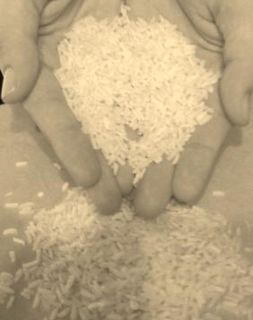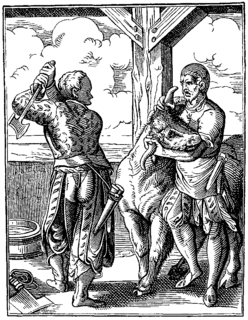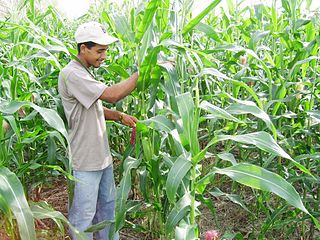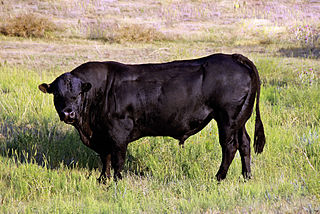Related Research Articles

The Federal Meat Inspection Act of 1906 (FMIA) is an American law that makes it a crime to adulterate or misbrand meat and meat products being sold as food, and ensures that meat and meat products are slaughtered and processed under sanitary conditions. These requirements also apply to imported meat products, which must be inspected under equivalent foreign standards. USDA inspection of poultry was added by the Poultry Products Inspection Act of 1957. The Food, Drug, and Cosmetic Act authorizes the FDA to provide inspection services for all livestock and poultry species not listed in the FMIA or PPIA, including venison and buffalo. The Agricultural Marketing Act authorizes the USDA to offer voluntary, fee-for-service inspection services for these same species.

The Animal and Plant Health Inspection Service (APHIS) is an agency of the United States Department of Agriculture (USDA) based in Riverdale, Maryland responsible for protecting animal health, animal welfare, and plant health. APHIS is the lead agency for collaboration with other agencies to protect U.S. agriculture from invasive pests and diseases. APHIS is the National Plant Protection Authority for the U.S. government, and the agency's head of veterinary services is Chief Veterinary Officer of the United States.
A downer is an animal, usually livestock, that cannot stand on its own and therefore is to be killed. A downed animal, one that is unable to stand, is not necessarily a downer.

A feedlot or feed yard is a type of animal feeding operation (AFO) which is used in intensive animal farming for finishing livestock, notably beef cattle, but also swine, horses, sheep, turkeys, chickens or ducks, prior to slaughter. Large beef feedlots are called concentrated animal feeding operations (CAFO) in the United States and intensive livestock operations (ILOs) or confined feeding operations (CFO) in Canada. They may contain thousands of animals in an array of pens.

Different cattle feeding production systems have separate advantages and disadvantages. Most cattle in the US have a diet that is composed of at least some forage. In fact, most beef cattle are raised on pasture from birth in the spring until autumn. Then for pasture-fed animals, grass is the forage that composes all or at least the great majority of their diet. Cattle fattened in feedlots are fed small amounts of hay supplemented with grain, soy and other ingredients in order to increase the energy density of the diet. The debate is whether cattle should be raised on diets primarily composed of pasture (grass) or a concentrated diet of grain, soy, corn and other supplements. The issue is often complicated by the political interests and confusion between labels such as "free range", "organic", or "natural". Cattle raised on a primarily forage diet are termed grass-fed or pasture-raised; for example meat or milk may be called grass-fed beef or pasture-raised dairy. However, the term "pasture-raised" can lead to confusion with the term "free range", which does not describe exactly what the animals eat.

The National Agricultural Statistics Service (NASS) is the statistical branch of the U.S. Department of Agriculture and a principal agency of the U.S. Federal Statistical System. NASS has 12 regional offices throughout the United States and Puerto Rico and a headquarters unit in Washington, D.C.. NASS conducts hundreds of surveys and issues nearly 500 national reports each year on issues including agricultural production, economics, demographics and the environment. NASS also conducts the United States Census of Agriculture every five years.

The Grain Inspection, Packers and Stockyards Administration (GIPSA) was an agency of the United States Department of Agriculture that facilitates the marketing of livestock, poultry, meat, cereals, oilseeds, and related agricultural products, and promotes fair and competitive trading practices for the overall benefit of consumers and American agriculture. GIPSA was formed in 1994 through the joining of the Federal Grain Inspection Service and the Packers and Stockyards Administration.
The term meat industry describes modern industrialized livestock agriculture for production, packing, preservation and marketing of meat. In economics, it is a fusion of primary (agriculture) and secondary (industry) activity and hard to characterize strictly in terms of either one alone. The greater part of the entire meat industry is termed meat packing industry- the segment that handles the slaughtering, processing, packaging, and distribution of animals such as cattle, pigs, sheep and other livestock.
In the United States, a commodity checkoff program collects funds through a checkoff mechanism, sometimes called checkoff dollars, from producers of a particular agricultural commodity and uses these funds to promote and do research on that particular commodity. The organizations must promote their commodity in a generic way, without reference to a particular producer. Checkoff programs attempt to improve the market position of the covered commodity by expanding markets, increasing demand, and developing new uses and markets. Checkoff programs amount to $750 million per year.

Food policy is the area of public policy concerning how food is produced, processed, distributed, and purchased. Food policies are designed to influence the operation of the food and agriculture system. This often includes decision-making around production and processing techniques, marketing, availability, utilization and consumption of food, in the interest of meeting or furthering social objectives. Food policy can be promulgated on any level, from local to global, and by a government agency, business, or organization. Food policymakers engage in activities such as regulation of food-related industries, establishing eligibility standards for food assistance programs for the poor, ensuring safety of the food supply, food labeling, and even the qualifications of a product to be considered organic.
Food politics are the political aspects of the production, control, regulation, inspection, distribution and consumption of food. The politics can be affected by the ethical, cultural, medical and environmental disputes concerning proper farming, agricultural and retailing methods and regulations.

The Under Secretary for Marketing and Regulatory Programs is a high-ranking position within the United States Department of Agriculture that supervises policy development and day-to-day operations of the Animal and Plant Health Inspection Service, the Agricultural Marketing Service, and the Grain Inspection, Packers, and Stockyards Administration. The three agencies were appropriated over $800 million by Congress in fiscal year 2004.

The Packers and Stockyards Act of 1921 was enacted following the release in 1919 of the Report of the Federal Trade Commission on the meatpacking industry.

Animal slaughter is the killing of animals, usually referring to killing domestic livestock. In general, the animals would be killed for food; however, they might also be slaughtered for other reasons such as being diseased and unsuitable for consumption. The slaughter involves some initial cutting, opening the major body cavities to remove the entrails and offal but usually leaving the carcass in one piece. Such dressing can be done by hunters in the field or in a slaughterhouse. Later, the carcass is usually butchered into smaller cuts.
Country of origin labeling (COOL) is a requirement signed into American law under Title X of the Farm Security and Rural Investment Act of 2002, codified at 7 U.S.C. § 1638a as Notice of country of origin. This law had required retailers to provide country-of-origin labeling for fresh beef, pork, and lamb. The program exempted processed meats. The United States Congress passed an expansion of the COOL requirements on September 29, 2008, to include more food items such as fresh fruits, nuts and vegetables. Regulations were implemented on August 1, 2008, August 31, 2008, and May 24, 2013. The 2016 Consolidated Appropriations Act is the latest amendment to the Agricultural Marketing Act of 1946. This act forms the basis of the current COOL requirements.
President Chester A. Arthur signed the Animal Industry Act on May 29, 1884 creating the Bureau of Animal Industry (BAI), an organization that was established under the United States Department of Agriculture. It replaced the Veterinary Division that had been created by the Commissioner of Agriculture in 1883, which had taken over for the Treasury Cattle Commission, Department of Treasury.

Agriculture in Panama is an important sector of the Panamanian economy. Major agricultural products include bananas, cocoa beans, coffee, coconuts, timber, beef, chicken, shrimp, corn, potatoes, rice, soybeans, and sugar cane.
The Sheep Promotion, Research, and Information Act of 1994 enabled domestic sheep producers and feeders and importers of sheep and sheep products to develop, finance, and carry out a nationally coordinated program for sheep and sheep product promotion, research, and information.

North American Piedmontese cattle are a breed of domestic beef cattle originating from an imported herd of select Italian purebred Piedmontese cattle. The foundation line of breeding stock was first imported from Italy into Canada in 1979, and into the United States in the early 1980s. Piedmontese cattle are distinguished by a unique, naturally occurring gene identified as the myostatin allele mutation, or inactive myostatin gene. Myostatin prohibits muscle growth whereas an inactive gene has the opposite effect. Purebred Piedmontese are homozygous,, which means they have two identical alleles present for this unique gene. Research indicates the presence of the myostatin allele mutation produces morphological characteristics unique to the breed, such as double-muscling, beef tenderness, reduced fat content and high yield. According to the North American Piedmontese Association (NAPA), they are the first breed registry to base animal registration requirements on the presence of this specific gene which can be easily verified by DNA testing.
Countries regulate the marketing and sale of beef by observing criteria of cattle carcasses at the abattoir and classifying the carcasses. This classification, sometimes optional, can suggest a market demand for a particular animal's attributes and therefore the price owed to the producer.
References


The Congressional Research Service (CRS), known as Congress's think tank, is a public policy research arm of the United States Congress. As a legislative branch agency within the Library of Congress, CRS works primarily and directly for Members of Congress, their Committees and staff on a confidential, nonpartisan basis.